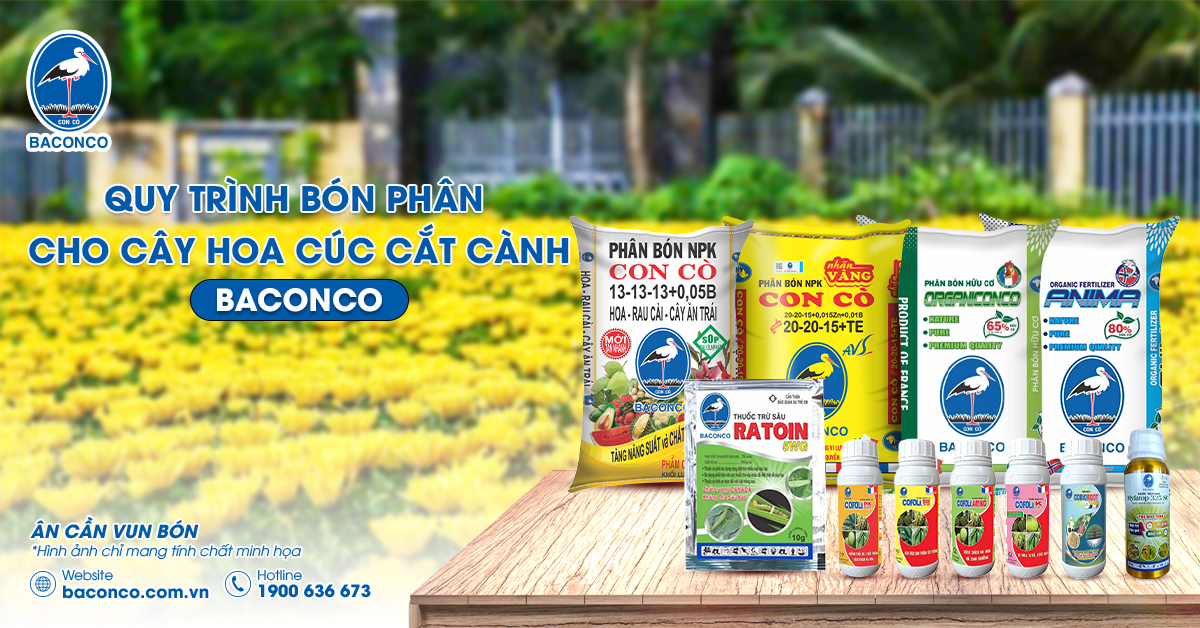The Secret to Fertilizing Cut Chrysanthemum Flowers for High Economic Efficiency
14 Feb 2025

Discover the secret to properly fertilizing cut chrysanthemum flowers, helping the plants grow healthy, bloom beautifully, on time, and optimize costs for high economic efficiency with Baconco!
Common characteristics of chrysanthemum plants
Chrysanthemum plants are one of the most popular crops, loved for their beauty and high economic value. Below are the common characteristics of chrysanthemum plants, helping growers understand more about the conditions for growth and development of this plant:
Prefers cool climates
Chrysanthemum plants grow best in cool climates, with an ideal temperature of 15-20°C. This is why chrysanthemums are often grown in high, cool regions like Da Lat.
Prefers stable soil and air humidity
The suitable soil moisture for chrysanthemum plants is around 60-70%, while the ideal air humidity is 55-65%. This ensures the plants grow healthily and minimizes pests and diseases.
Requires appropriate light
Chrysanthemums' growth and flowering are greatly dependent on light:
- Long day light: Helps the plants grow quickly and develop stems and leaves.
- Short day light: Promotes the flowering process.
Therefore, the method of using lights at night is often applied in intensive chrysanthemum cultivation, helping to control the flowers to bloom simultaneously.
Soil requirements
Chrysanthemum plants are suitable for planting in loose, well-drained soil that is rich in organic matter and nutrients. This helps the roots grow strong and provide enough nutrients for the growth process.
Ability to grow year-round
Chrysanthemums can be grown year-round, especially in greenhouse conditions like in Da Lat, where the climate is cool and the light is ideal. This offers flexibility in production and supplying flowers to the market.
The fertilization process for economic efficiency for cut chrysanthemum plants
Fertilizing cut chrysanthemums incorrectly can lead to late flowering, smallerrorerror, pale colors, and many stems... resulting in low yield and severely affecting economic sources.
To ensure cut chrysanthemum plants grow well, bloom evenly, beautifully, and bring high profits, growers need to follow the correct fertilization process. Below is a detailed guide to help farmers easily apply:
Initial fertilization stage when planting (dosage for an area of 1,000m²):
- Spread 50-100kg of lime powder or dolomite on the soil before planting to neutralize acidity and improve the soil.
- Apply 100-150kg of organic fertilizer (such as ORGANICONCO organic fertilizer or ANIMA organic fertilizer) to provide long-term nutrients for the plants.
- Mix the fertilizer evenly with the soil, then water to ensure the soil is moist before planting.
Fertilization stage (10 and 20 days after planting):
- Dissolve 30-50g of NPK CON CO 20-20-15+TE AVS yellow label or NPK NPK CON CO fertilizer 13-13-13+0,05B in 10 liters of water.
- Evenly water this solution at the base of the plants, about 200-300ml per plant depending on the size.
- Repeat 2 times, after 10 days and 20 days of planting.
Fertilization phase:
NPK CON CO fertilizer 13-13-13+0,05B is recommended for flowers, vegetables and fruit trees. Image: Baconco.
Fertilization is an important step to help plants grow strong and produce buds and flowers evenly. Farmers should divide it into 3 fertilization times:
- First time (25-30 days after planting): Apply 50-60kg of NPK CON CO fertilizer 13-13-13+0,05B/1,000m² to help the plants develop strong stems and leaves.
- Second time (40-45 days after planting): Apply 40-50kg of NPK CON CO fertilizer 13-13-13+0,05B/1,000m² to prepare the plants for budding.
- Third time (55-60 days after planting): Apply 40-50kg of NPK CON CO fertilizer 13-13-13+0,05B/1,000m² to nourish the buds and help the flowers bloom evenly and beautifully.
Note: After each fertilization, farmers need to water adequately to ensure the fertilizer dissolves evenly and the plants absorb it better.
Leaf spraying phase:
Spraying on the leaves helps plants absorb nutrients quickly, increases resistance, and supports beautiful flower blooming. The spraying stages are as follows:
Stage 1: Post-planting period – light interruption:
Mix the solution: COFOLI AMINO (2ml/liter of water), COBIO ROOT (2ml/liter of water), and RATOIN. Spray regularly every 7-10 days for good plant growth.
Stage 2: Budding preparation period:
Mix the solution: COFOLI PK500 (2ml/liter of water), COFOLI K300 (2ml/liter of water), RATOIN, and MYFATOP. Spray regularly every 7-10 days to support healthy, even budding.
Stage 3: Flower nurturing period:
Mix the solution: COFOLI MAX36 (2ml/liter of water), Cofoli K300 (2ml/litererrorerror water), RATOIN, and MYFATOP. Spray regularly every 7-10 days for beautiful, long-lasting flowers that retain their color.
Important notes:
- Fertilize with the correct dosage: Do not over-fertilize to avoid root burn or weak growth.
- Water regularly: After each fertilization, water immediately to ensure the fertilizer dissolves evenly and the roots can absorb it easily.
- Adjust lighting:
- Chrysanthemum plants need long daylight to grow and short daylight to bloom.
- Farmers can use nighttime lighting to control the plants to bloom simultaneously at the right time.
Baconco hopes that our products and guidance will make it easier for farmers to grow cut chrysanthemums, bringing in a bountiful harvest with beautifully blooming flowers that achieve high economic efficiency. Wishing farmers continued success!
Views
787
